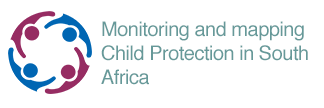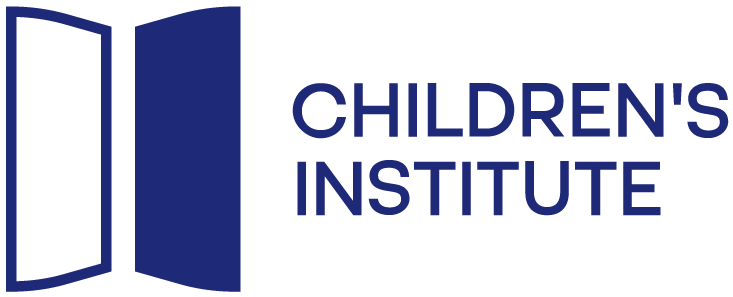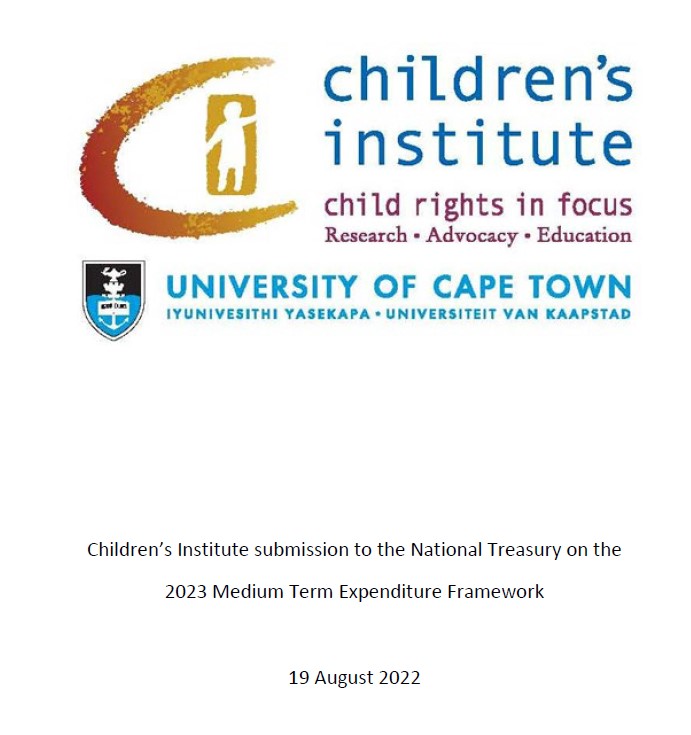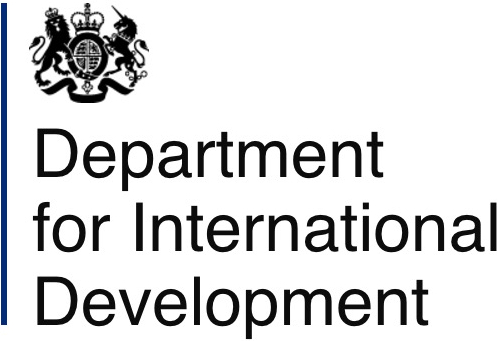Definition
This indicator measures the number and percentage of children who have passed grades 3 and 9 by the appropriate age. Grade 3 progression is based on children aged 10-11 years; Grade 9 progression is based on children aged 16-17 years. The age limit is generous. If a child started school in the year that they turned 7 and progressed one grade every year, they would be expected to complete Grade 3 in the year that they turn 9, and Grade 9 in the year that they turn 15.Data
Source
Statistics South Africa (2003 - 2025) General Household Survey 2002 - 2024. Pretoria, Cape Town: Statistics South Africa.
Analysis by Katharine Hall & Sumaiyah Hendricks, Children's Institute, University of Cape Town.
Analysis by Katharine Hall & Sumaiyah Hendricks, Children's Institute, University of Cape Town.
Notes
- Children are defined as persons aged 0 – 17 years. The proportions for this indicator are based on children in the age group appropriate for school level: Completion of Gr 3: 10 – 11 years; Completion of Gr 9: 16 – 17 years.
- Population numbers have been rounded off to the nearest thousand.
- Sample surveys are always subject to error, and the proportions simply reflect the mid-point of a possible range. The confidence intervals (CIs) indicate the reliability of the estimate at the 95% level. The wider the CI, the more uncertain the proportion. Where CIs overlap for different sub-populations or time periods we cannot be sure that there is a real difference in the proportion, even if the mid-point proportions differ. CIs are represented in the bar graph by vertical lines at the top of each bar.
What do the numbers tell us?
School attendance rates are very high during the compulsory schooling phase (Grades 1 – 9). However, attendance tells us little about the quality of education that children receive, or their progress through the education system.
Previous systemic evaluations by the DBE have recorded very low pass rates in numeracy and literacy among both Grade 3 and Grade 6 learners,1 and internationally comparative studies have repeatedly found South Africa’s performance to be poor even when compared with other countries in the region. Both the 2016 and 2021 international PIRLS studies, which assessed literacy among Grade 4 learners, found that four out of five Grade 4 children in South Africa could not read for meaning in any language.2 In the international TIMMS study, which assessed numeracy among Grade 5 learners, South Africa was placed second last out of 49 countries. Three out of five learners could not do basic arithmetic calculations like addition and subtraction.3 Despite measures to address the inherited inequities in the education system through revisions to the legislative and policy frameworks and the school funding norms, continued disparities in the quality of education offered by schools reinforce existing socio-economic inequalities, limiting the future work opportunities and life chances of children who are born into poor households.4
High rates of grade repetition have been recorded in numerous studies. An analysis of grade promotion, repetition and dropout using administrative data showed that in 2019, 12% of Grade 1 learners were not promoted to the next year and repeated the grade. In the same year 9% of Grade 2s and 7% of Grade 3s repeated their grade. Repetition rates are much higher in the senior phase, where 17% of Grade 8s and 14% of Grade 9s repeated the year.5 Progression rates were considerably higher in 2020, perhaps because the criteria for grade promotion were relaxed in light of extensive disruption of the teaching programme during lockdown. For those who are not properly evaluated at foundation and intermediate phase, automatic promotion may lead to higher rates of repetition and dropout in the upper grades and affect matric pass rates down the line.
A study of children’s progress at school, using 2008 data from the National Income Dynamics Study, found that only about 44% of young adults (age 21 – 29) had matriculated, and of these less than half had matriculated “on time”.6 In 2016, only 51% of young people aged 20 – 24 had completed a matric or matric equivalent.7 In South Africa, the labour market returns to education only start kicking in on successful completion of matric, not before. However, it is important to monitor progress and grade repetition in the earlier grades as slow progress at school is a strong determinant of school dropout.8
The South African schooling system is divided into three-year phases: the “foundation phase” (Grades 1 to 3), the intermediate phase (Grades 4 to 6), the senior phase (Grades 7 to 9) and the further education and training phase (Grades 10 to 12). Assuming that children are enrolled in primary school at the prescribed age (by the year in which they turn seven) and assuming that they do not repeat a grade or drop out of school, they would be expected to have completed the foundation phase (Grade 3) by the year that they turn nine, and the general education phase (Grade 9) by the year they turn 15.
This indicator allows a little more leeway and therefore provides a generous estimate of school progress: it measures the number and percentage of children aged 10 and 11 who have completed a minimum of Grade 3, and the percentage of those aged 16 and 17 who have completed a minimum of Grade 9. In other words, it allows for the older cohort in each group to have repeated one grade.
In 2022, 93% of all children aged 10 and 11 were reported to have completed Grade 3, up from 78% in 2002. An improvement in progress through the foundation phase was evident across most of the provinces, with significant advances in the Eastern Cape (from 64% in 2002 to 90% in 2022), Mpumalanga (75% to 96%), Limpopo (80% to 96%) and KwaZulu-Natal (75% to 93%). These improvements have narrowed the gap between provinces, although it is uncertain to what extent this reflects real improvements in education or arises from stricter rules limiting the number of grades that can be repeated within a school phase.
As would be expected, the rate of progression through the entire general education and training band (up to Grade 9) is lower, as there is more time for children to have repeated or dropped out by the end of Grade 9. Three quarters of children aged 16 – 17 years had completed Grade 9 in 2022, while one quarter had not attained this level of schooling. This represents an overall improvement of almost 20 percentage points over the two decades from 50% in 2002. Provincial variation is slightly more pronounced than for progress through the foundation phase with Gauteng having the highest rate of Grade 9 progression (85%), followed by the Western Cape (75%). Progress was poorest in the Northern Cape, North West, Free State and Eastern Cape, where less than 70% of children had completed Grade 9 by the expected age.
As found in other analyses of transitions through school,9 educational attainment (measured by progress through school) varies along socio-economic and racial lines. These differences become more pronounced as children advance through the grades. Gender differences in school progression have remained consistent and even widened over the years: girls are more likely than boys to progress through school at the expected rate and the difference becomes more pronounced in the higher grades. In 2022, the gender difference in grade progression for Grade 3 learners was not significant (94% for girls versus 92% for boys). But in the same year, 82% of 16 – 17-year-old girls had completed Grade 9, compared with only 67% of boys in the same age cohort. These findings are consistent with previous analyses from different data sources.10
There are significant differences in grade completion across income quintiles, especially amongst children who have completed Grade 9: in 2022, 67% of 16 – 17-year-olds in the poorest 20% of households had completed Grade 9, compared to 92% of those in the richest 20% of households.
The most striking improvements in grade progression, at both Grade 3 and Grade 9 level, occurred through the years between 2002 and 2010. The rate of improvement has slowed and in some years remained stable since then.
Of course, grade progression and grade repetition are not easy to interpret. Prior to Grade 12, the promotion of a child to the next grade is based mainly on assessment by teachers, and the measure may be confounded by the teacher’s competence to assess the performance of the child, as well as pressure on teachers and/or schools to promote children through the system. Analyses of the determinants of school progress and dropout point to a range of factors, many of which are interrelated: there is huge variation in the quality of education offered by schools. These differences largely reflect the historic organisation of schools into racially defined and inequitably resourced education departments. Household-level characteristics and family background also account for some of the variation in grade progression. For example, the level of education achieved by a child’s mother explains some of the difference in whether children are enrolled at an appropriate age and whether they go on to complete matric successfully.11 This in turn suggests that improved educational outcomes for children will have a cumulative positive effect for each subsequent generation.
1 Department of Basic Education. Report on the Annual National Assessments of 2014. Pretoria: DBE. 2014.
2 Howie S, Combrinck C, Tshele M, Roux K, Palane NM, Mokoena G. PIRLS 2016 Progress in International Reading Literacy study 2016 Grade 5 BenchMark Participation: South African Children's Reading Literacy Achievement. Pretoria: Centre for Evaluation and Assessment. 2017.
Mullis IVS, von Davieer M, Foy P, Fishbein B, Reynolds KA, Wry E. PIRLS 2021 International Results in Reading. Boston: Boston College, TIMSS & PIRLS International Study Center. 2023. https://doi.org/10.6017/lse.tpisc.tr2103.kb5342
3 Reddy V, Visser M, Winnaar L, Arends F, Juan A, Prinsloo C, Isdale K. TIMSS 2015: Highlights of Mathematics and Science Achievement of Grade 9 South African Learners. Human Sciences Research Council. 2016.
4 South African Human Rights Commission, UNICEF. Poverty Traps and Social Exclusion among Children in South Africa 2014. Pretoria: SAHRC and UNICEF. 2014
Zoch A. Life Chances and Class: Estimating inequality of opportunity in South Africa over various life stages. Stellenbosch Economic Working Papers 08/13. Stellenbosch University. 2013.
Spaull N. Schooling in South Africa: How low quality education becomes a poverty trap. In: Lannoy AD, Swartz S, Lake L, Smith C, editors. South African Child Gauge 2015: Children's Institute, University of Cape Town; 2015.
5 Department of Basic Education. Grade promotion, repetition and dropping out 2018 to 2021: Data report. Pretoria: DBE. 2023.
6 Timæus I, Simelane S, Letsoalo T. Poverty, race and children's progress at school in South Africa. The Journal of Development Studies. 2013, 49(2):270-284.
7 Youth Explorer. Youth Explorer: 2018. Accessed: 20 September. Available from: https://youthexplorer.org.za/profiles/country-ZA-south-africa/#education.
8 Branson N, Hofmeyer C, Lam D. Progress through school and the determinants of school dropout in South Africa. Development Southern Africa. 2014, 31(1):106-126.
9 Lam D, Ardington A, Leibbrandt M. Schooling as a lottery: Racial differences in school advancement in urban South Africa. Journal of Development Economics. 2011, 95:133-136.
S van der Berg, C Burger, R Burger, M de Vos, M Gustafsson, E Moses, . . . D von Fintel. Low Quality Education as a Poverty Trap. Stellenbosch: Stellenbosch University. 2011.
Branson N, Lam D. Educational inequality in South Africa: Evidence from the National Income Dynamics Study. Studies in Economics and Econometrics. 2010, 34(3):85-105.
10 Fleisch B, Shindler J. Gender repetition: School access, transitions and equity in the 'Birth-to-Twenty' cohort panel study in urban South Africa. Comparative Education. 2009, 45(2):265-279.
11 Timæus I, Simelane S, Letsoalo T. Poverty, race and children's progress at school in South Africa. The Journal of Development Studies. 2013, 49(2):270-284.
Previous systemic evaluations by the DBE have recorded very low pass rates in numeracy and literacy among both Grade 3 and Grade 6 learners,1 and internationally comparative studies have repeatedly found South Africa’s performance to be poor even when compared with other countries in the region. Both the 2016 and 2021 international PIRLS studies, which assessed literacy among Grade 4 learners, found that four out of five Grade 4 children in South Africa could not read for meaning in any language.2 In the international TIMMS study, which assessed numeracy among Grade 5 learners, South Africa was placed second last out of 49 countries. Three out of five learners could not do basic arithmetic calculations like addition and subtraction.3 Despite measures to address the inherited inequities in the education system through revisions to the legislative and policy frameworks and the school funding norms, continued disparities in the quality of education offered by schools reinforce existing socio-economic inequalities, limiting the future work opportunities and life chances of children who are born into poor households.4
High rates of grade repetition have been recorded in numerous studies. An analysis of grade promotion, repetition and dropout using administrative data showed that in 2019, 12% of Grade 1 learners were not promoted to the next year and repeated the grade. In the same year 9% of Grade 2s and 7% of Grade 3s repeated their grade. Repetition rates are much higher in the senior phase, where 17% of Grade 8s and 14% of Grade 9s repeated the year.5 Progression rates were considerably higher in 2020, perhaps because the criteria for grade promotion were relaxed in light of extensive disruption of the teaching programme during lockdown. For those who are not properly evaluated at foundation and intermediate phase, automatic promotion may lead to higher rates of repetition and dropout in the upper grades and affect matric pass rates down the line.
A study of children’s progress at school, using 2008 data from the National Income Dynamics Study, found that only about 44% of young adults (age 21 – 29) had matriculated, and of these less than half had matriculated “on time”.6 In 2016, only 51% of young people aged 20 – 24 had completed a matric or matric equivalent.7 In South Africa, the labour market returns to education only start kicking in on successful completion of matric, not before. However, it is important to monitor progress and grade repetition in the earlier grades as slow progress at school is a strong determinant of school dropout.8
The South African schooling system is divided into three-year phases: the “foundation phase” (Grades 1 to 3), the intermediate phase (Grades 4 to 6), the senior phase (Grades 7 to 9) and the further education and training phase (Grades 10 to 12). Assuming that children are enrolled in primary school at the prescribed age (by the year in which they turn seven) and assuming that they do not repeat a grade or drop out of school, they would be expected to have completed the foundation phase (Grade 3) by the year that they turn nine, and the general education phase (Grade 9) by the year they turn 15.
This indicator allows a little more leeway and therefore provides a generous estimate of school progress: it measures the number and percentage of children aged 10 and 11 who have completed a minimum of Grade 3, and the percentage of those aged 16 and 17 who have completed a minimum of Grade 9. In other words, it allows for the older cohort in each group to have repeated one grade.
In 2022, 93% of all children aged 10 and 11 were reported to have completed Grade 3, up from 78% in 2002. An improvement in progress through the foundation phase was evident across most of the provinces, with significant advances in the Eastern Cape (from 64% in 2002 to 90% in 2022), Mpumalanga (75% to 96%), Limpopo (80% to 96%) and KwaZulu-Natal (75% to 93%). These improvements have narrowed the gap between provinces, although it is uncertain to what extent this reflects real improvements in education or arises from stricter rules limiting the number of grades that can be repeated within a school phase.
As would be expected, the rate of progression through the entire general education and training band (up to Grade 9) is lower, as there is more time for children to have repeated or dropped out by the end of Grade 9. Three quarters of children aged 16 – 17 years had completed Grade 9 in 2022, while one quarter had not attained this level of schooling. This represents an overall improvement of almost 20 percentage points over the two decades from 50% in 2002. Provincial variation is slightly more pronounced than for progress through the foundation phase with Gauteng having the highest rate of Grade 9 progression (85%), followed by the Western Cape (75%). Progress was poorest in the Northern Cape, North West, Free State and Eastern Cape, where less than 70% of children had completed Grade 9 by the expected age.
As found in other analyses of transitions through school,9 educational attainment (measured by progress through school) varies along socio-economic and racial lines. These differences become more pronounced as children advance through the grades. Gender differences in school progression have remained consistent and even widened over the years: girls are more likely than boys to progress through school at the expected rate and the difference becomes more pronounced in the higher grades. In 2022, the gender difference in grade progression for Grade 3 learners was not significant (94% for girls versus 92% for boys). But in the same year, 82% of 16 – 17-year-old girls had completed Grade 9, compared with only 67% of boys in the same age cohort. These findings are consistent with previous analyses from different data sources.10
There are significant differences in grade completion across income quintiles, especially amongst children who have completed Grade 9: in 2022, 67% of 16 – 17-year-olds in the poorest 20% of households had completed Grade 9, compared to 92% of those in the richest 20% of households.
The most striking improvements in grade progression, at both Grade 3 and Grade 9 level, occurred through the years between 2002 and 2010. The rate of improvement has slowed and in some years remained stable since then.
Of course, grade progression and grade repetition are not easy to interpret. Prior to Grade 12, the promotion of a child to the next grade is based mainly on assessment by teachers, and the measure may be confounded by the teacher’s competence to assess the performance of the child, as well as pressure on teachers and/or schools to promote children through the system. Analyses of the determinants of school progress and dropout point to a range of factors, many of which are interrelated: there is huge variation in the quality of education offered by schools. These differences largely reflect the historic organisation of schools into racially defined and inequitably resourced education departments. Household-level characteristics and family background also account for some of the variation in grade progression. For example, the level of education achieved by a child’s mother explains some of the difference in whether children are enrolled at an appropriate age and whether they go on to complete matric successfully.11 This in turn suggests that improved educational outcomes for children will have a cumulative positive effect for each subsequent generation.
1 Department of Basic Education. Report on the Annual National Assessments of 2014. Pretoria: DBE. 2014.
2 Howie S, Combrinck C, Tshele M, Roux K, Palane NM, Mokoena G. PIRLS 2016 Progress in International Reading Literacy study 2016 Grade 5 BenchMark Participation: South African Children's Reading Literacy Achievement. Pretoria: Centre for Evaluation and Assessment. 2017.
Mullis IVS, von Davieer M, Foy P, Fishbein B, Reynolds KA, Wry E. PIRLS 2021 International Results in Reading. Boston: Boston College, TIMSS & PIRLS International Study Center. 2023. https://doi.org/10.6017/lse.tpisc.tr2103.kb5342
3 Reddy V, Visser M, Winnaar L, Arends F, Juan A, Prinsloo C, Isdale K. TIMSS 2015: Highlights of Mathematics and Science Achievement of Grade 9 South African Learners. Human Sciences Research Council. 2016.
4 South African Human Rights Commission, UNICEF. Poverty Traps and Social Exclusion among Children in South Africa 2014. Pretoria: SAHRC and UNICEF. 2014
Zoch A. Life Chances and Class: Estimating inequality of opportunity in South Africa over various life stages. Stellenbosch Economic Working Papers 08/13. Stellenbosch University. 2013.
Spaull N. Schooling in South Africa: How low quality education becomes a poverty trap. In: Lannoy AD, Swartz S, Lake L, Smith C, editors. South African Child Gauge 2015: Children's Institute, University of Cape Town; 2015.
5 Department of Basic Education. Grade promotion, repetition and dropping out 2018 to 2021: Data report. Pretoria: DBE. 2023.
6 Timæus I, Simelane S, Letsoalo T. Poverty, race and children's progress at school in South Africa. The Journal of Development Studies. 2013, 49(2):270-284.
7 Youth Explorer. Youth Explorer: 2018. Accessed: 20 September. Available from: https://youthexplorer.org.za/profiles/country-ZA-south-africa/#education.
8 Branson N, Hofmeyer C, Lam D. Progress through school and the determinants of school dropout in South Africa. Development Southern Africa. 2014, 31(1):106-126.
9 Lam D, Ardington A, Leibbrandt M. Schooling as a lottery: Racial differences in school advancement in urban South Africa. Journal of Development Economics. 2011, 95:133-136.
S van der Berg, C Burger, R Burger, M de Vos, M Gustafsson, E Moses, . . . D von Fintel. Low Quality Education as a Poverty Trap. Stellenbosch: Stellenbosch University. 2011.
Branson N, Lam D. Educational inequality in South Africa: Evidence from the National Income Dynamics Study. Studies in Economics and Econometrics. 2010, 34(3):85-105.
10 Fleisch B, Shindler J. Gender repetition: School access, transitions and equity in the 'Birth-to-Twenty' cohort panel study in urban South Africa. Comparative Education. 2009, 45(2):265-279.
11 Timæus I, Simelane S, Letsoalo T. Poverty, race and children's progress at school in South Africa. The Journal of Development Studies. 2013, 49(2):270-284.
Technical notes
The General Household Survey asks: "What is the highest level of education that ... has sucessfully completed?"
The response categories are broken down into individual grades. This indicator reflects those who have successfully completed Grade 3 or higher (for the younger age group), and Grade 9 or higher (for the older age group).
The response categories are broken down into individual grades. This indicator reflects those who have successfully completed Grade 3 or higher (for the younger age group), and Grade 9 or higher (for the older age group).
Strengths and limitations of the data
The numbers are derived from the General Household Survey, a multi-purpose annual survey conducted by the national statistical agency, Statistics South Africa, to collect information on a range of topics from households in the country’s nine provinces.
The GHS uses a Master Sample frame which has been developed as a general-purpose household survey frame that can be used by all other Stats SA household-based surveys that have design requirements that are reasonably compatible with the GHS. The sample is drawn from Census enumeration areas using a stratified two-stage design with probability proportional to size sampling of PSUs in teh first stage, and sampling of dwelling units with systematic sampling in the second stage. The resulting sample consists of just over 20,000 households with around 70,000 individuals, and should be representative of all households in South Africa. It is also designed to be representative at provincial level and within provinces at metro/non-metro levels and three geography types (urban areas, rural areas under traditional authority, and farms).
The sample consists of households and does not cover other collective institutionalised living-quarters such as boarding schools, orphanages, students’ hostels, old-age homes, hospitals, prisons, military barracks and workers’ hostels. These exclusions probably do not have a noticeable impact on the findings in respect of children.
Changes in sample frame and stratification
Since 2014 the GHS has been based on the 2013 master sample that that is, in turn, based on information collected during the 2011 Population Census. The previous master sample for the GHS was used for the first time in 2008, and the one before that in 2004. These again differed from the master sample used in the first two years of the GHS: 2002 and 2003. Thus there have been four different sampling frames during history of the annual GHS, with the changes occurring in 2004, 2008 and 2013. In addition, there have been changes in the method of stratification over the years. These changes could compromise comparability across iterations of the survey to some extent, although it is common practice to use the GHS for longitudinal monitoring and many of the official trend analyses are drawn from this survey.
Weights
Person and household weights are provided by Stats SA and are applied in Children Count analyses to give population estimates on the indicators. The GHS weights are derived from Stats SA’s mid-year population estimates for the relevant year. The population estimates are based on a model that is revised from time to time when it is possible to calibrate the population model to Census data and larger population surveys such as the Community Survey.
In 2017, Stats SA revised its demographic model to produce a new series of mid-year population estimates and the GHS data were re-released with the revised population weights. All the Children Count indicators were re-analysed retrospectively, using the revised weights provided by Stats SA, based on the 2013 model. The estimates are therefore comparable over all years. The revised weights particularly affected estimates for the years 2002 – 2007.
The 2017 model drew on the 2011 census, along with vital registration, antenatal and other administrative data, but was a “smoothed” model that did not mimic the unusual shape of the age distribution found in the census. The results of the 2011 census were initially distrusted because it seemed to over-count children in the 0 – 4 age group and under-count children in the 4 – 14-year group. It is now thought that the fertility rates recorded in the 2011 population census may have been an accurate reflection of demopraphic trends, with an unexplained upswing in fertility around 2009 after which fertility rates declined again gradually. Similar patterns were found in the vital registration data as more births were reported retrospectively to the Department of Home Affairs, and in administrative data from schools, compiled by the Department of Basic Education. In effect, this means that there may be more children in South Africa than appear from the analyses presented in these analyses, where we have applied weights based on a model that it is now known to be inaccurate.
Stats SA has subsequently developed a new population model - the 2022 series, which provides revised mid-year population estimates back to 2002 and projected to 2032. However, the GHS series has not yet been reweighted.The population estimates in Children Count are therefore based on weights derived from outdated population model (2017). It is not yet clear when and how the population model will be revised again following the 2022 Census, as there are concerns around census under-count and plausibility of its findings.
Disaggregation
Statistics South Africa suggests caution when attempting to interpret data generated at low level disaggregation. The population estimates are benchmarked at the national level in terms of age, sex and population group while at provincial level, benchmarking is by population group only. This could mean that estimates derived from any further disaggregation of the provincial data below the population group may not be robust enough.
Reporting error
Error may be present due to the methodology used, i.e. the questionnaire is administered to only one respondent in the household who is expected to provide information about all other members of the household. Not all respondents will have accurate information about all children in the household. In instances where the respondent did not or could not provide an answer, this was recorded as “unspecified” (no response) or “don’t know” (the respondent stated that they didn’t know the answer).
For more information on the methods of the General Household Survey, see the metadata for the respective survey years, available on Nesstar or DataFirst
The GHS uses a Master Sample frame which has been developed as a general-purpose household survey frame that can be used by all other Stats SA household-based surveys that have design requirements that are reasonably compatible with the GHS. The sample is drawn from Census enumeration areas using a stratified two-stage design with probability proportional to size sampling of PSUs in teh first stage, and sampling of dwelling units with systematic sampling in the second stage. The resulting sample consists of just over 20,000 households with around 70,000 individuals, and should be representative of all households in South Africa. It is also designed to be representative at provincial level and within provinces at metro/non-metro levels and three geography types (urban areas, rural areas under traditional authority, and farms).
The sample consists of households and does not cover other collective institutionalised living-quarters such as boarding schools, orphanages, students’ hostels, old-age homes, hospitals, prisons, military barracks and workers’ hostels. These exclusions probably do not have a noticeable impact on the findings in respect of children.
Changes in sample frame and stratification
Since 2014 the GHS has been based on the 2013 master sample that that is, in turn, based on information collected during the 2011 Population Census. The previous master sample for the GHS was used for the first time in 2008, and the one before that in 2004. These again differed from the master sample used in the first two years of the GHS: 2002 and 2003. Thus there have been four different sampling frames during history of the annual GHS, with the changes occurring in 2004, 2008 and 2013. In addition, there have been changes in the method of stratification over the years. These changes could compromise comparability across iterations of the survey to some extent, although it is common practice to use the GHS for longitudinal monitoring and many of the official trend analyses are drawn from this survey.
Weights
Person and household weights are provided by Stats SA and are applied in Children Count analyses to give population estimates on the indicators. The GHS weights are derived from Stats SA’s mid-year population estimates for the relevant year. The population estimates are based on a model that is revised from time to time when it is possible to calibrate the population model to Census data and larger population surveys such as the Community Survey.
In 2017, Stats SA revised its demographic model to produce a new series of mid-year population estimates and the GHS data were re-released with the revised population weights. All the Children Count indicators were re-analysed retrospectively, using the revised weights provided by Stats SA, based on the 2013 model. The estimates are therefore comparable over all years. The revised weights particularly affected estimates for the years 2002 – 2007.
The 2017 model drew on the 2011 census, along with vital registration, antenatal and other administrative data, but was a “smoothed” model that did not mimic the unusual shape of the age distribution found in the census. The results of the 2011 census were initially distrusted because it seemed to over-count children in the 0 – 4 age group and under-count children in the 4 – 14-year group. It is now thought that the fertility rates recorded in the 2011 population census may have been an accurate reflection of demopraphic trends, with an unexplained upswing in fertility around 2009 after which fertility rates declined again gradually. Similar patterns were found in the vital registration data as more births were reported retrospectively to the Department of Home Affairs, and in administrative data from schools, compiled by the Department of Basic Education. In effect, this means that there may be more children in South Africa than appear from the analyses presented in these analyses, where we have applied weights based on a model that it is now known to be inaccurate.
Stats SA has subsequently developed a new population model - the 2022 series, which provides revised mid-year population estimates back to 2002 and projected to 2032. However, the GHS series has not yet been reweighted.The population estimates in Children Count are therefore based on weights derived from outdated population model (2017). It is not yet clear when and how the population model will be revised again following the 2022 Census, as there are concerns around census under-count and plausibility of its findings.
Disaggregation
Statistics South Africa suggests caution when attempting to interpret data generated at low level disaggregation. The population estimates are benchmarked at the national level in terms of age, sex and population group while at provincial level, benchmarking is by population group only. This could mean that estimates derived from any further disaggregation of the provincial data below the population group may not be robust enough.
Reporting error
Error may be present due to the methodology used, i.e. the questionnaire is administered to only one respondent in the household who is expected to provide information about all other members of the household. Not all respondents will have accurate information about all children in the household. In instances where the respondent did not or could not provide an answer, this was recorded as “unspecified” (no response) or “don’t know” (the respondent stated that they didn’t know the answer).
For more information on the methods of the General Household Survey, see the metadata for the respective survey years, available on Nesstar or DataFirst






 The SAECR 2024 tracks trends on the status of children under 6.
The SAECR 2024 tracks trends on the status of children under 6. 








